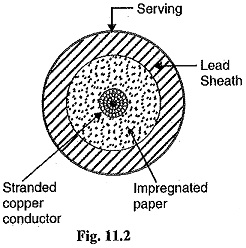Classification of Underground Cables:
Classification of Underground Cables may be in two ways according to
- the type of insulating material used in their manufacture
- the voltage for which they are manufactured.
However, the latter method of Classification of Underground Cables is generally preferred, according to which cables can be divided into the following groups :
- Low-tension (L.T.) cables – upto 1000 V
- High-tension (H.T.) cables – upto 11,000 V
- Super-tension (S.T.) cables – from 22 kV to 33 kV
- Extra high-tension (E.H.T.) cables – from 33 kV to 66 kV
- Extra super voltage cables – beyond 132 kV
A cable may have one or more than one core depending upon the type of service for which it is intended. It may be
- single-core
- two-core
- three-core
- four-core etc.
For a 3-phase service, either 3-single-core cables or three-core cable can be used depending upon the operating voltage and load demand.
Fig. 11.2 shows the constructional details of a single-core low tension cable. The cable has ordinary construction because the stresses developed in the cable for low voltages (upto 6600 V) are generally small. It consists of one circular core of tinned stranded copper (or aluminium) insulated by layers of impregnated paper. The insulation is surrounded by a lead sheath which prevents the entry of moisture into the inner parts. In order to protect the lead sheath from corrosion, an overall serving of compounded fibrous material (jute etc.) is provided. Single-core cables are not usually armoured in order to avoid excessive sheath losses. The principal advantages of single-core cables are simple construction and availability of larger copper section.
